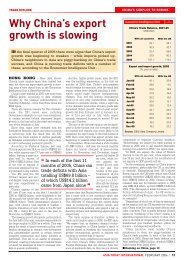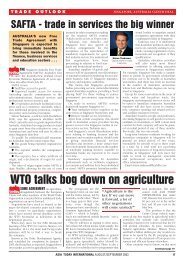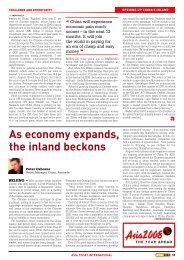indonesia - Asia Today International
indonesia - Asia Today International
indonesia - Asia Today International
Create successful ePaper yourself
Turn your PDF publications into a flip-book with our unique Google optimized e-Paper software.
THE REGIONIran throwsdown thegauntlet on LNGMEETING ASIA’S ENERGY GAPAndrew SymonASIA TODAY INTERNATIONALCorrespondentPETROLEUM developmentin Iran geared to meeting<strong>Asia</strong>’s hunger for energy isadvancing — despite US economicsanctions and growingtension between Tehranand Washington. Iran hassigned off deals with bothChina and India...SINGAPORE — Major non-American,western companies — and <strong>Asia</strong>n companies —are taking supply positions upstream in oil andgas-rich Iran and, on the demand side, signingpurchase agreements even though they risksanctions being imposed on business intereststhey have in the US.Iran’s natural gas reserves especially havebecome an attractive prize. While historicallymuch greater priority has been given to oil —with the Islamic state exporting east and west2.6 million barrels a day of its total four millionbarrels a day production — the export potentialof natural gas is now being embraced byTehran, foreign companies and <strong>Asia</strong>n governments.With the world’s second-largest provenreserves (942 trillion cu ft) after those of Russia,Iran promises to become a key exporter of liquefiednatural gas (LNG) to markets east of Suez.The LNG industry, built around a transportationtechnology where natural gas is liquefied,shipped to consumers and then returned to itsgaseous state, is projected to at least double insize in the coming decade as demand grows,plants are expanded and new ones built, supplyprices fall and commercial contracts becomemore flexible.The Australian Government’s AustralianBureau of Agricultural and Resource Economicsforecasts LNG demand in the <strong>Asia</strong> Pacificregion at 150 million tonnes by 2015 comparedwith 75 million tonnes in 2002 (table page 15).Tehran has ambitions for LNG export productionof 40 million tonnes per year of LNG. Fourseparate plants are proposed, fed by the vastSouth Pars gasfield offshore the mid-southcoast. This would mean revenue of the order ofUS$10 billion a year at today’s prices.While industry consultants say it is unlikelyany plant will be in operation before 2010,warning that Iranian Government contract conditionscan make petroleum projects difficult toadvance commercially, Iran’s potential as anLNG supplier — given <strong>Asia</strong>’s energy needs —Natural gas liquefaction facilities at the Petronas-run Bintulu plantin Sarawak.seems to ensure that the Middle East state willemerge as a major gas exporter.This is underlined by recent agreementsbetween the State-owned National Iranian OilCompany (NOIC) and the Chinese and IndianState petroleum companies, Sinopec andONGC. These preliminary agreements featurelong-term supply of Iranian LNG and participationby the Chinese and Indian companies indevelopment of oil and gas fields in Iran. Newoil output would also be sold to Chinese andIndian markets.“China and India have realised that packagingtheir potential LNG demand as a means ofcreating baseload sales to enable the launch ofIran LNG plants allows them a quid pro quo toget into Iran upstream, particularly oil,” says AlTroner, Managing Director of Seattle-based<strong>Asia</strong> Pacific Energy Consulting.Although US energy companies have beencompletely barred from any business with Iran,Sinopec, ONGC and other non-US companiesseem undeterred by US policy, or concerns thatthe Middle East state is a supporter of internationalterrorism and seeking nuclear weaponscapacity. Iran holds 11 per cent of the world’s❝ With the world’ssecond-largest provenreserves (942 trillion cu ft)after those of Russia, Iranpromises to become a keyexporter of LNG to marketseast of Suez. ❞proven oil reserves, is OPEC’s second largest oilproducer, and has 15 per cent of the world’sproven natural gas reserves.It is not only the new energy-consuminggiants, India and China, that are turning to Iran.Japanese companies are also moving upstreaminto Iranian oil production. A consortium led byInpex signed an agreement last year with NIOCto develop the reportedly huge Azadeganonshore oil field in Iran’s southwest for supplymainly to JapanOther major companies already operating inIran are Anglo Dutch Shell, British Gas, Total ofFrance, Russia’s Gazprom, Italy’s ENI/Agip,Norway’s Statoil and Norsk Hydro, Canada’sBow Valley Energy, Malaysia’s Petronas andChina’s CNPC.US measures imposed against Iran becauseof its support for international terrorism anddevelopment of weapons of mass destructionban both investment and trade by US companiesin and with Iran, and threaten sanctions onnon-US companies investing in Iran’s petroleumsector, the mainstay of Iran’s economy.Preventing development of the petroleum sectoris argued as a way of inhibiting funding ofterrorism and weapons development.Non-US companies which invest US$40 millionor more in Iran’s petroleum sector may havesanctions imposed on any business activitiesthey have in the US.Until now, the latter sanctions have proved tobe a paper tiger. Offending foreign companieshave escaped sanctions because, as providedunder the 1996 Iran-Libya Sanctions Act, theUS President has been able to waive sanctionson the basis that they would either not be in thegreater national interest of the US or becausethe offending company’s country has agreed toundertake measures to inhibit Iran’s activitiesin support of terrorism and acquisition ofweapons of mass destruction.Now, with Iran becoming more a focus of theUS Bush Administration’s Middle East policy inthe last year, with fear that Tehran is developingnuclear weapons capacity, a lobby for sterneraction against offending foreign companies isgrowing. A Bill is before Congress to strengthenand expand the 1996 Act.Washington's concerns were underlined duringthe visit of the new US Secretary of State,Condoleeza Rice, to New Delhi in mid-March.Rice told India’s leaders the US opposed developmentof a gas pipeline from Iran to nothernIndia.The 2,700-km pipeline from the South Parsfield running through Pakistan has long beenmooted. But its development has been hinderedby the difficulty of supplying gas at a lowenough price to enter South <strong>Asia</strong>n markets.Another obstacle is the waxing and waningof relations between India and Pakistan.Concern remains in India over the possibility ofgas supply being interrupted by Pakistanshould relations between the two countriesdeteriorate.Iran claims its nuclear programme is forCONTINUED PAGE 15 ➔ASIA TODAY INTERNATIONAL APRIL 2005 | 13Greg Suharsono/ATI

















